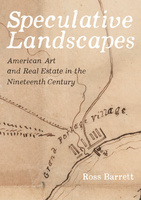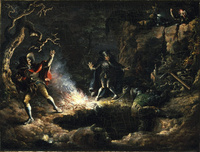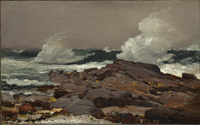Speculative Landscapes: American Art and Real Estate in the Nineteenth Century by Ross Barrett
Reviewed by Kim OrcuttKim Orcutt
independent scholar
Email the author: kimorcutt301[at]gmail.com
Citation: Kim Orcutt, book review of Speculative Landscapes: American Art and Real Estate in the Nineteenth Century by Ross Barrett, Nineteenth-Century Art Worldwide 22, no. 1 (Spring 2023), https://doi.org/10.29411/ncaw.2023.22.1.11.
This work is licensed under a Creative Commons Attribution-NonCommercial 4.0 International License  unless otherwise noted.
unless otherwise noted.
Your browser will either open the file, download it to a folder, or display a dialog with options.

Ross Barrett,
Speculative Landscapes: American Art and Real Estate in the Nineteenth Century.
Berkeley: University of California Press, 2022.
256 pp.; 85 color illus.; notes; selected bibliography; illustration list; index.
$65 (hardcover and ebook), £55 (hardcover and ebook)
ISBN: 9780520343917
Ross Barrett’s book Speculative Landscapes: American Art and Real Estate in the Nineteenth Century explores the phenomenon of artists participating in the overheated real estate markets that tempted potential investors with the prospect of large returns in an era of rapid national expansion. The topic is a fascinating one that acknowledges the financial realities of artists’ lives, and the book builds on recent scholarly interest in examining the art market and the monetary underpinnings of the art world.[1] This volume goes further in exploring specific artists’ financial ventures in the precarious world of nineteenth-century real estate investing in the US. Barrett aims to show that, for the artists studied, their involvement with real estate was not disconnected from their work; rather, it led them to create paintings intended to express their unease and ambivalence about their real estate activities and their effects. Speculative Landscapes contains impressive archival research and is abundantly illustrated with the visual culture of real estate development, including surveys, maps, and promotional materials. While it offers an absorbing view of the unexpected ties between the arenas of art and real estate development, it achieves mixed success in persuading the reader of its specific thesis.
The author begins with a characterization of real estate’s role in the present-day economy: “American real estate capitalism as we now know it” is, in Barrett’s view, “a market-based system of property exchange imbricated in financial networks, powered by unsustainable speculation, bolstered by cultural representations, and intertwined with inequity” (1). Barrett then sets the stage in his introduction by explaining how “privatizing” the United States’ expanded lands in the nineteenth century—at the expense of indigenous peoples—gave rise to a chaotic array of speculative schemes. His examination of the effects of land policies, banking, easy credit, and marketing strategies sketches a picture of a speculative market that attracted many investors, including the artists under discussion. The following chapters present case studies of five artists who were particularly actively involved in real estate developments, some more speculative in nature than others. Barrett structures each chapter in a similar way, which lends strength to his arguments and makes for a smooth and lucid reading experience. Each chapter begins by describing the artist’s specific roles in different types of real estate ventures that extended from the East Coast to the South and the Midwest. These sections are carefully researched and fascinating in their own right, describing the ups and downs, the anxiety of risk, and sometimes, the rewards. It is worth noting that Barrett regularly restates his thesis, an exemplary practice that propels his arguments forward. He then discusses specific artworks that are posited as each artist’s conflicted or even interrogatory response to his experience with real estate enterprise. Often the author brings to bear new (to this writer) background information that enhances one’s understanding of familiar works. Barrett offers close readings of visual elements of artworks to support his argument, which seem considerably more subjective. Artists’ intentions are also discerned in their handling of paint and choices of natural elements included in the image, such as soil, rocks, and plant life. Finally, period commentary is presented from critics who condemned the negative aspects of development, the moral perils of speculation and unearned wealth, the disastrous impacts on indigenous peoples, the displacement of longtime residents’ homes and livelihoods, and connections with slavery and free Black labor. These accounts are presented as surrogates for the artist’s point of view; Barrett frequently asserts that the artists under discussion shared the views informing these accounts, and that those views are reflected in their work.
It is important to emphasize the admirable quality of the research and writing brought to bear in this volume. However, there is some epistemological ambiguity in how the author goes about proving his thesis that the paintings discussed represent the artist’s purposeful effort to express concern or even criticism of the real estate activities in which he participated. The author employs a combination of contextual information, close reading, and contemporary commentary as evidence of artist’s intent. The rich contextual materials deepen our understanding of the artworks under discussion, but they have their limits. While artworks are informed by their time and place, artists’ intentions cannot always be gleaned from them. The element of close reading, perhaps undertaken as a semiotic approach to unearthing meaning in the images, also raises concerns as a way of discerning artists’ goals. It is itself a speculative endeavor to be employed with caution, since we bring our own biases conditioned by our era and prevailing scholarly interests to even the most well-documented historical accounts. Finally, Barrett posits connections based on artists’ temporal and geographic proximity to thoughts that others expressed, and that the paintings studied echo claims of period thinkers. However, our own personal experience shows that our nearness to someone in time and space does not demonstrate that we share their views.

As a result, while all of the case studies are well researched and written, some of them are more persuasive than others in proving that the paintings under discussion expressed the artist’s internal conflicts about his encounter with real estate investment. The chapters are presented in chronological order, beginning with Daniel Huntington and the commission he undertook for paintings to promote the planned town of Verplanck in New York’s Westchester County (though it is unclear whether Huntington actually invested in the scheme). The paintings are not extant, but the author draws deftly from contextual clues to suggest the views that they might have depicted. His reading of Mercy’s Dream (1841, fig. 1), however, is less convincing. The painting depicts an episode from John Bunyan’s moralizing allegory Pilgrim’s Progress (1684). Barrett posits that the dimly lit landscape background represents a subversion of the land’s value, and the closed eyes of the slumbering character Mercy signify not only sleep, but also a rejection of the speculative value of the landscape behind her. It is suggested that Huntington later chose to depict remote areas rather than better-known sites because they were less attractive to investors.

Chapter 2 on John Quidor is very persuasive because fairly direct evidence exists of the artist’s intentions for the paintings discussed, and that material points the way to the methodology employed. Since Quidor took as his subject Washington Irving’s tale “The Money Diggers” (1824), which deals with issues of property and speculation, Barrett is able to unpack the literal and allegorical messages in Irving’s tale as they relate to Quidor’s paintings. Barrett skillfully unravels Irving’s complex narrative and Quidor’s artworks, such as Money Diggers (1832, fig. 2), are described in rich detail. A great deal is read into the handling of paint in certain areas. However, because the key argument is well supported, a few allusive suggestions are readily absorbed. The chapter ends poignantly with Quidor’s disastrous attempt to incorporate his artwork into a real estate investment.

The next chapter focuses on Eastman Johnson. It describes the artist’s early experiences with real estate ventures in the Lake Superior region and later in Nantucket, Massachusetts. The author focuses on two paintings of the Grand Portage Reservation in Wisconsin as a hybrid space caught between forms of occupancy exercised by indigenous peoples and Euro-American settlers. In painting two views that were, as far as we know, accurate renderings of the camp, the author considers them as purposeful framings of “a space of resistance and assimilation” (85). In an enlightening interpretation of The Cranberry Harvest (1880, fig. 3), Barrett reveals the subject not as a nostalgic community enterprise, but rather as a relatively modern accommodation to new economic realities, pointing out details in the painting such as the workers’ bent postures and a possible supervisor figure that suggest the subject of the painting is less picturesque work than hard labor.

Chapter 4 on Martin Johnson Heade dives into the heady boom and bust world of Floridian real estate and the industry of building its identity as the “sunshine state.” It delineates Heade’s own entrepreneurial ventures and the anxieties that accompanied them. The author positions On the San Sebastian River (ca. 1886–88, fig. 4) as Heade’s attempt to interrogate Florida boosterism with its stormy weather and its swampland subject, which were both common past motifs but are unusual for this period in his oeuvre. Contextual information on the economic and racial implications of the background adds new dimensions to our understanding of the work. Barrett points out, however, that the painting was a “demonstration piece” on view in his St. Augustine studio, making the reader wonder why, given Heade’s financial concerns, he would exhibit a painting that, according to the author, was intended to subvert and undermine the very enterprise in which he was so heavily invested. The assertion calls for a psychoanalytic reading of Heade as deeply self-sabotaging and would benefit from further explanation.

The last chapter, on works by Winslow Homer, describes his and his family’s development activities on Prouts Neck, Maine, in the larger context of the area’s growing popularity as a tourist destination and the impacts on its longtime residents. Barrett presents three works as illustrations of the artist’s ambivalence about the privatization and gentrification that Homer and his family helped to usher in. The author’s in-depth analysis of the form of fishing seen in Bringing in the Nets (1887) illuminates the difficulty and the economic realities of the work depicted. The cursory inclusion of the existing cottages and hotels in the distance is interpreted as a protest against their existence. Barrett’s analysis of A Summer Night (1890) sheds new light on this famously mysterious work and argues convincingly for the awkward juxtaposition of the resort world in the foreground and the wild sea beyond. Less persuasive is his argument for Eastern Point (1900, fig. 5), one of Homer’s many scenes of the Maine Coast, that his rendering of this particular coastline alludes to the liminal and ambiguous nature of tidewater boundaries since it depicts property that the artist owned. The chapter ends with the author suggesting that Homer advocated reimagining the relationship between public and private property, a bold premise that is belied by Homer’s actions.
Speculative Landscapes is well written and structured, richly detailed, and very readable, but the reader is occasionally asked to cross tricky logical chasms, and the text would benefit from greater methodological and epistemological clarity. The author’s argument rests on the supposition that the artists’ works are not consonant with their actions, but rather are in direct conflict with them, and even consciously intended to subvert them. This type of premise calls for stronger and more direct evidence. Caution is important when linking premises that are allusive by nature, and indeed, the author expresses different degrees of certainty in presenting his arguments (2, 3, 65, 71, 106, 136). The book might be even stronger if this mountain of solid and insightful scholarship was deployed in the service of a slightly different thesis that is directed not toward proving artistic intent, but rather toward an examination of the new meanings that accumulate in artworks through succeeding generations of viewers who bring their own histories to bear, meanings that show the artwork’s own richness and resonance over time, but may not be any that the artist could have anticipated.
Barrett concludes by linking these works to twentieth- and twenty-first-century projects by artists who overtly and purposefully expose the darker side of real estate development, for example, Hans Haacke and Gordon Matta Clark. The author credits the same intentions to the nineteenth-century artists under discussion and frames them as prophets of his own and others’ present-day concerns about real estate development, asserting that “they developed prescient forms of creative inquiry” (173). Our natural desire as scholars is to have our work say something about the past that has value to present-day readers, and the connections attempted in this book suggest that the author wishes the nineteenth-century white, male artists he discusses to share his point of view and embrace positions that are valued in the present day. This is an increasingly common approach to the history of art in the United States, but one that demands careful consideration, since it leads to the danger of projecting the present onto the past, rather than making every effort to allow the past to speak with its own voice. And indeed, with the exceptions noted above, Barrett illuminates a number of new perspectives from the period which make Speculative Landscapes, though a bit speculative in itself, worth reading.
Notes
[1] Key examples include John Ott and Robin Veder, eds., “Art and Economics” (special issue), American Art 33, no. 3 (Fall 2019) and Leo G. Mazow and Kevin M. Murphy, Taxing Visions: Financial Episodes in Late Nineteenth-Century American Art, exh. cat. (University Park, PA: The Pennsylvania State University Press, 2010).